I recently became acquainted with François Bourdages. Mr. Bourdages is one of the preeminent experts on bandes dessinées québécoises (BDQ), having previously curated a museum exhibit on the subject with historian Michel Viau in 2018 at the Musée POP in Trois-Rivières (formerly known as the Musée québécois de culture populaire). The exhibit was called L’art de la bande dessinée Québécoise. Bourdages also happens to have co-written one of the best texts about BDQ that I have seen. It has never been published, but he shared it with me for the benefit of my own research project. He also happens to have one of (if not the) largest private collections of BDQ in existence. Even more exciting is that he has offered to help me catalogue an assortment of BDQ from the Canadian Silver Age that I had been unaware of up to this point.
We became acquainted after I purchased a handful of BDQ from him on eBay, including some issues of Tchiize and Plouf that I had been trying to find for several years. One of the comics that I purchased from him that day was something that I had never heard of, which is always exciting. This particular BDQ has a lot going for it as a one-shot giveaway. Let’s take a look.
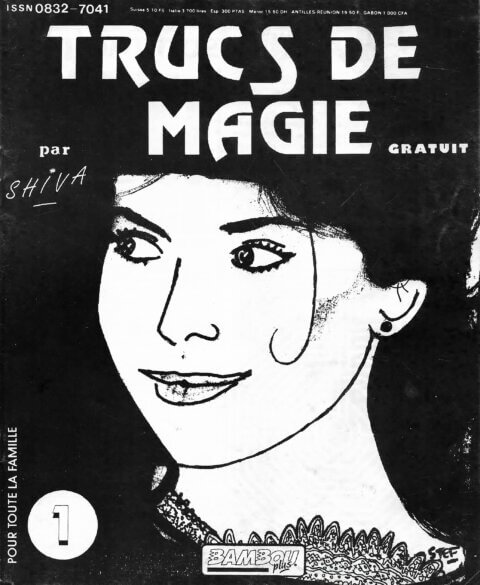
Trucs de Magie (which translates to “Magic Tricks” in English) was released in 1990 by Nommem’ART (formally known as Éditions La Bande décidée d’ici). This company is best known for releasing a series called Bambou that ran for seventeen issues from 1986 to 1990. Bambou was created and edited by Stéphane Delaprée (aka “Stef”) who also wrote and drew the majority of Trucs de Magie. Delaprée was born in France in 1956, but was raised in Quebec and Senegal. His foray into BDQ in the mid-1980s is only a small part of his trajectory as an artist. I will return to this later.
Bambou was one of the more successful independent BDQ series from the mid to late 1980s. It offered both comedic and realistic comic strips throughout its run and had quite a few contributors. Stef was involved for its entire run. At first it ran bimonthly, but was later published irregularly. The series was eventually retitled Bambou-Plus, which is the logo that is printed on the front of Trucs de Magie. Bambou released its final issue in September, 1990.
I know that Trucs de Magie was released towards the end of Bambou’s run because one of the advertisements inside of the comic is for the book Alexandra Wong by Jacques Bélanger and includes a review from La Press writer Gérald Leblanc that is dated May 2, 1990. From what I understand, Alexandra Wong’s initial release was on January 1, 1990, but did not have a wide release until October 1, 1990 (which is after the final issue of Bambou-Plus was released). As such, Trucs de Magie was released sometime in 1990, despite having a copyright date of 1986 in the indicia.
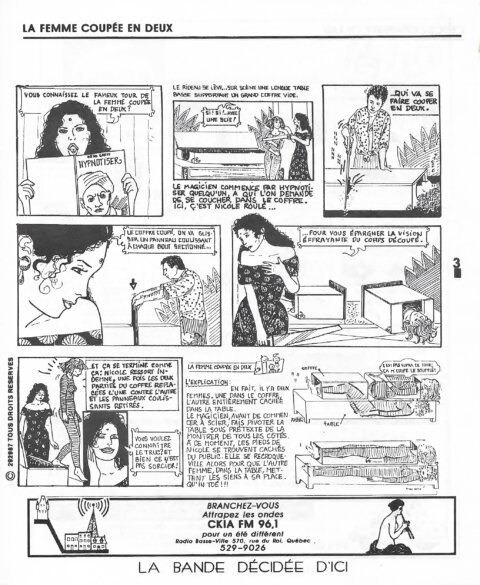
I have long been a fan of magic and illusion, to the extent that I have already covered the only other two Canadian comics that I know of that focus on magic and magicians. This BDQ hit all the right marks for me. Essentially Trucs de Magie presents several one-page comic strips where the magician, Shiva Shambou, reveals the secrets behind a particular magic trick.
Delaprée’s artwork and presentation is beautiful throughout this comic and it is a really fun and unique example of a giveaway from the end of the Canadian Silver Age. According to the indicia, the comic had a print run of 10,000 copies and was distributed for free in Quebec in conjunction with the Ministère des Affaires culturelles du Québec. Interestingly, the cover lists prices for several European and African countries, suggesting that the comic was circulated outside of Canada.
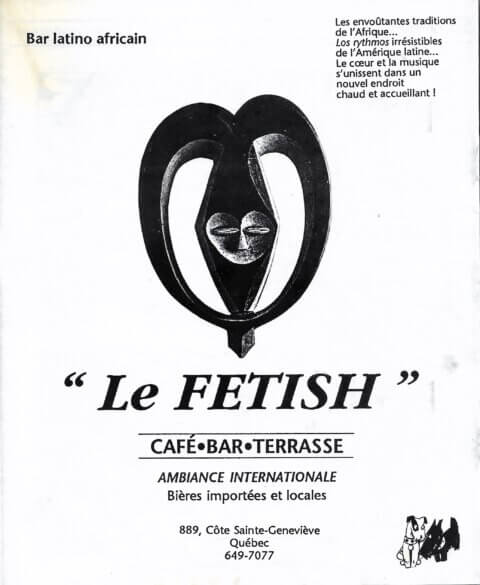
Given that the comic was a giveaway supported by the provincial government, it is no surprise that it is filled with advertisements for businesses from around Quebec City, where the both the provincial government and Bambou were based. Every page of the comic includes at least one advertisement for a local business, with the back cover featuring a full-page ad for a bar called “Le Fetish.”
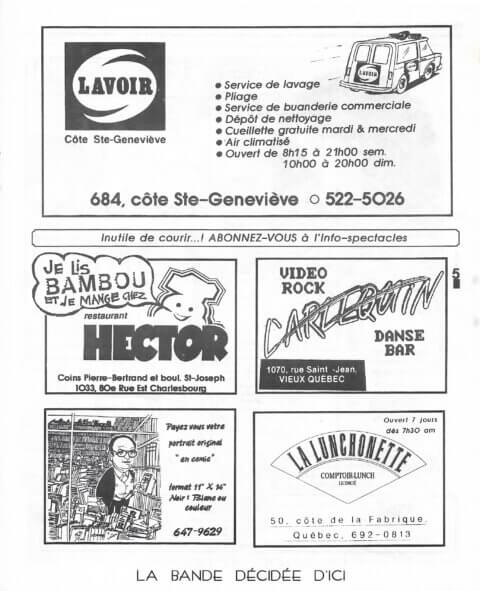
There are a couple of pages in the comic that serve only as advertisements. These pages offer a bit of a time capsule of businesses around Quebec City from 1990. In the page above there are two restaurants, a dance bar, a laundromat, and an artist for hire. One of the companies, Restaurant Hector, in still in business today.
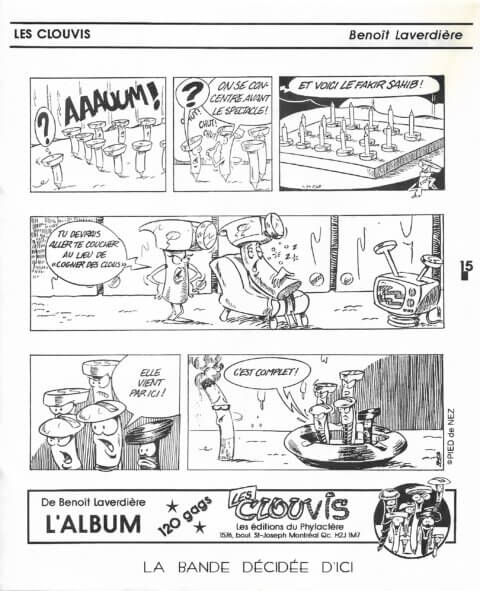
Breaking things up are a couple of one-page strips by Benoit Laverdière called “Les Clouvis” (which translates to “The Nails”). These comedic strips present the exploits of anthropomorphic nails, hammers, and other tools. Essentially, they are one note gags that don’t translate well to English. However, as seen above, they are included here in order to promote Laverdière’s full length comic. Although “Les Clouvis” doesn’t really fit the subject matter here, Laverdière did create the Bambou logo and was involved in the series. As such, I think of the inclusion of his strips here makes sense in terms of his relationship with Delaprée.
The Shiva Shambou strips, on the other hand, are the highlight of this comic. Delaprée’s depiction of magic tricks and explanation of how they work make this comic a must have for my BDQ collection. I particularly enjoy the “Woman Cut in Two” strip that I presented earlier, but there are others that I am also quite fond of.
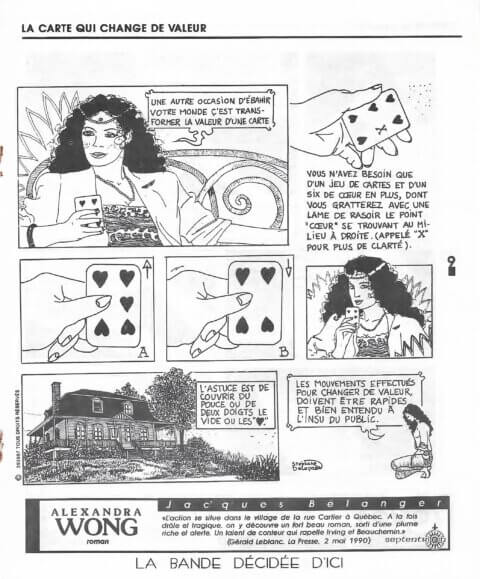
The trick, “The Card That Changes Value,” which is found in the middle of Trucs de Magie is a bit nostalgic for me, as it was included in the magic kit that I had as a child. I used to imagine that I was good at performing this trick when I was ten years old (though I realize that the adults were just placating me). Most of the tricks drawn by Delaprée rely on simple gimmicks (rather than cutting a woman in half), but that doesn’t detract from the magic for me, especially knowing that this giveaway was intended for an all-ages audience (as stated on the cover).
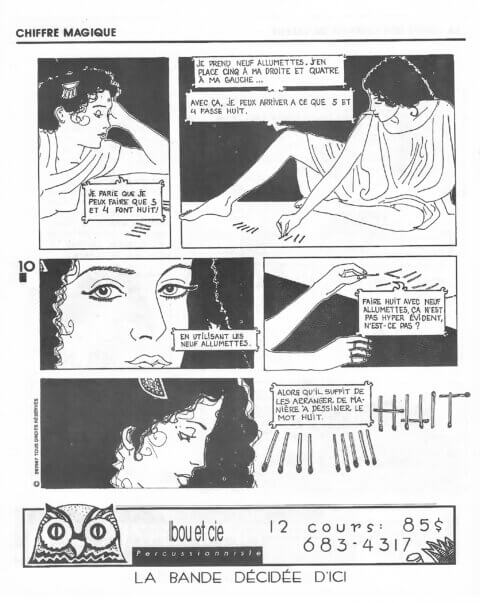
Despite this, there is one trick in the comic that I really don’t like because it relies on wordplay and can not be used by anyone other than French speaking audiences. I much prefer magic tricks that can work universally. Nevertheless, it is still an okay trick in principle. Here, Shiva is shown taking 9 matchsticks and turning them into “huit.” The trick is that she is supposed to take 9 matchsticks and turn them into 8 matchsticks, but really all she is doing is spelling out the word “huit” (which translates to “eight” in English). As such, this trick only works in French. That said, the weakness of this particular trick itself does not detract from Stef’s work here.
Despite a few things that I don’t like about Trucs de Magie, this really is a beautiful example of how comics can be used to promote and present just about any subject. I am glad to own a copy of this and it is one of the only “new” comics from the Canadian Silver Age that I have uncovered this year. I am hopeful that I will uncover several additional “new” BDQ from the era with the help of Mr. Bourdages.
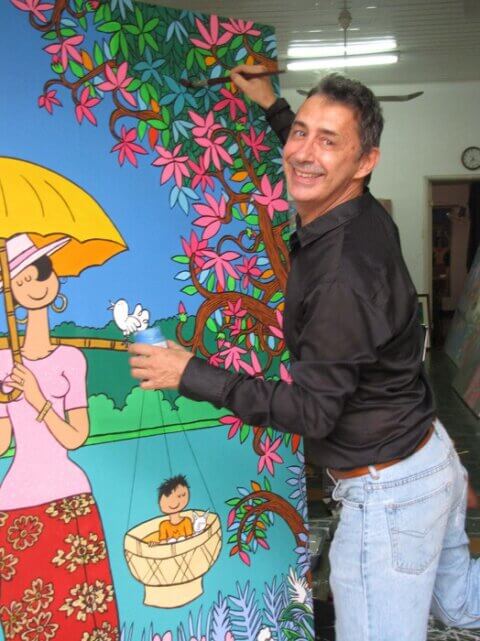
After Bambou ended, Delaprée left Canada. He spent some time in Costa Rica before relocating to Cambodia. From what I understand, he now splits his time between Cambodia and France. After leaving Canada he completely changed directions, becoming a painter, and developing an artistic style that he refers to as “Happy Painting.” Over nearly three decades, Stef has become one of the best-known artists in Cambodia and had his own gallery for many years in Phnom Penh. I am under the impression that Stef has closed his gallery and is semi-retired, spending his time travelling between France and Cambodia. However, his website is still active and he has artwork available for sale. You can see what he is up to at this link.
Now that I have quite a bit of new information about BDQ from the Canadian Silver Age to sift through, I am planning to do columns about French language comics more often moving forward. Of course, next month I endeavour to offer something completely different. I have mentioned a couple of times this year that I am planning to do a piece about a famous series from Quebec sometime soon. However, I have been spread quite thin with travel and events lately, so I won’t have a chance to delve into this until I have a bit more time at my disposal.
Speaking about travel and events, thanks to everyone who came out to last month’s East Coast Comic Expo (ECCE) in Moncton. It was the first time the event had been held since 2019 due to the pandemic and it was the largest ECCE ever held. The event is operated by a non-profit and everyone who puts the ECCE together is a volunteer. We have known many of the organizers for nearly a decade and they do an incredible job.

We were slammed for most of the event, so we didn’t get a chance to interact with the guests to the same extent as we had in the past, but we did get a chance to hang out with several creators who stopped by our booth, including Michael de Adder, Dave Howlett, Andrew Clark, Tony White, Justin Coffee, and André Myette. The East Coast Comic Expo continues to be the best comic event on Canada’s east coast. We can’t wait until next year!
We have many more events on our calendar in the months ahead, including the annual NBAAC Flea Market in Sussex, NB in August, and Hal-Con in October. Keep an eye out on our Facebook and Instagram pages for more information. We are also starting to experiment with Meta’s new platform, Threads.
Thanks again for your readership and see you next month with another look at some weird Canadian comics from yesteryear.

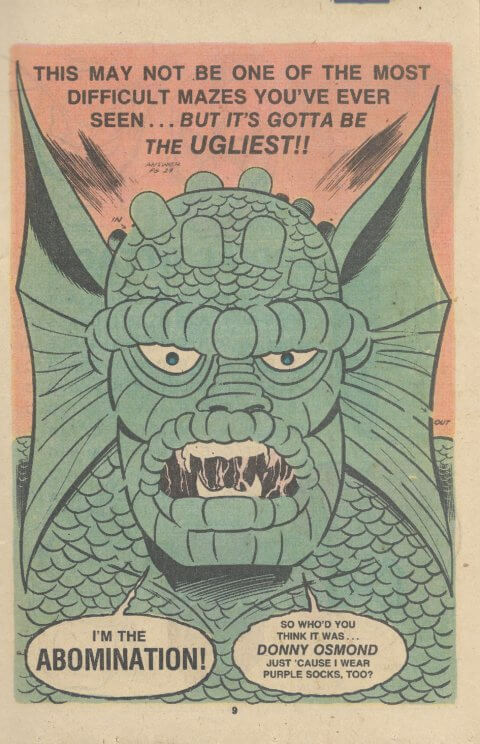
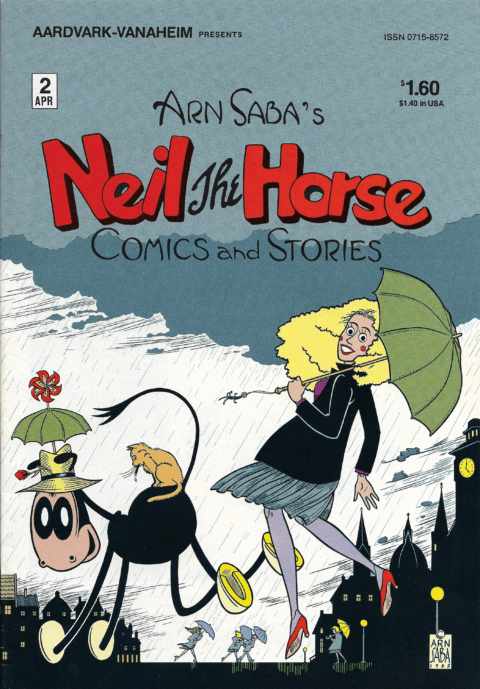
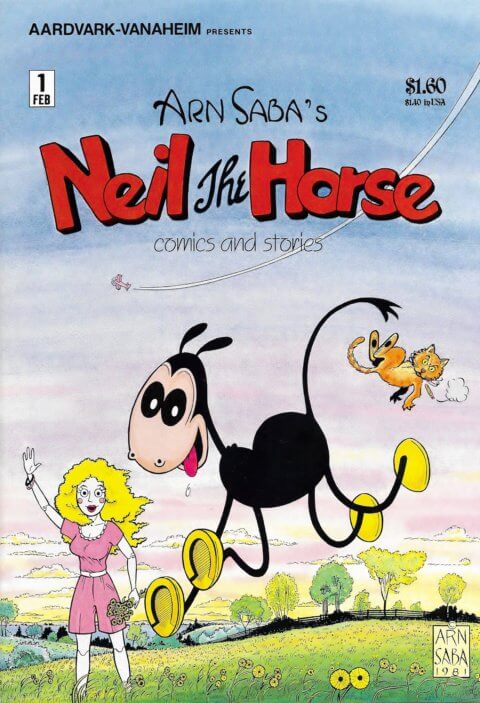
CORRECTION
It has come to my attention that I mistakenly claimed that Mr. Bourdages was a co-author on the text about BDQ that I mention early in this column. In reality, Mr. Michel Viau was the sole author of the text that I received. I confused their working together on an exhibit with the text that Mr. Viau wrote, which actually is related to a prior exhibit he put on called “Les Fanzines: Un espace de liberté.”
The context of the work is clearly explained on the second page of the PDF of Mr. Viau’s research that I have on hand, which I overlooked. This mistake is entirely my own. As such, I would like to apologize to both Mr. Viau and Mr. Bourdages for my error and for any confusion it has caused.